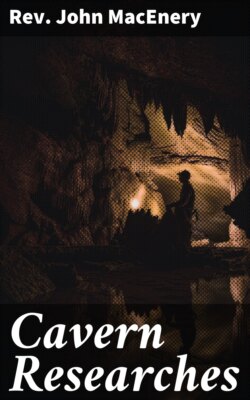Читать книгу Cavern Researches - Rev. John MacEnery - Страница 7
На сайте Литреса книга снята с продажи.
APPROACH TO THE CAVERN.
ОглавлениеTable of Contents
It is in the midst of this scene of disorder that the rock of Kent’s Cavern rises, half-way between St. Mary-Church and Torquay, from each of which places it is about a mile distant.
Those who may be desirous to view the district just sketched, preparatory to a visit to the cavern, should approach it from the St. Mary-Church road, which sweeps down by Anstis’ Cove, showing the nature and condition of the strata on a sufficiently intelligible scale.—From the Roman camp on the Down, the eye may follow the outline of the coast from the limit of the limestone at Petit-Tor, to the junction of the sandstone with the chalk. On a clear day the Oolitic island of Portland may also be descried.
The approach from Torquay is by a lane, near the turnpike, which terminates in a wooded valley, flanked on both sides by ridges of limestone. In that on the right is situated the cavern. The ascent to it is gradual. The way lies over a stony gap, after which it winds up through brushwood in front of the mouths.
The grey masses scattered down the side, as ready to drop from the brow of the hill,—its rugged and creviced surface, through which the coppiswood strikes into the interior,—its stratification partly vertical, partly horizontal, are so many traces of the igneous revolution, which, at a remote period, seems to have created the cavern for the reception of the aqueous deposits of a later convulsion, and those evidences which connect the primitive with the historic period.
Two apertures near the summit of the hill give access to the cavern. That on the right appears to have always been the favorite entrance. It is simply a cleft in the rock, of the shape of a wedge reversed, diminishing from its base upwards; it is about seven feet wide at the bottom and five feet high. Before the removal of the mould to render the passage more accessible the cleft was not more than four feet high. The mouth on the left is a shallow arch formed by a natural span of the strata, loose masses of which project above, overhanging the entrance. In its present state it has no more than three feet of elevation, but in its natural condition, before the soil was raised as a fence against cattle, it was about five feet in height and nine in breadth. When we cleared away the rubbish we found the rock floor polished as by constant use. On the inside the entrance rises rapidly and spreads out into a spacious vault.
These mouths are about 46 ft. apart from each other, nearly in a line, and upon the same side of the rock, of the irregularity of whose beds their remarkable difference of form is a just type.
In giving an account of our excavations, we shall follow the order pursued by the guides, so that those who may have visited, or who may hereafter visit the cavern, may be enabled to follow us.
We shall commence then with the common entrance—thence follow the direct course of the upper gallery,—and its lateral branches or sallyports. We shall then return on our steps as far as the vestibule, or sloping chamber, and, without stopping, advance by the arcade into the cave at its extremity,—from which we shall turn on the left into the region of the Bear’s Den or of the “Water.”
We shall return thence by the oven, retrace our steps by the arcade, traverse once more the sloping chamber in our way to the Wolf’s Den, which forms its right branch, and finally terminate our labours in the grand vestibule or Hyena’s Den.
